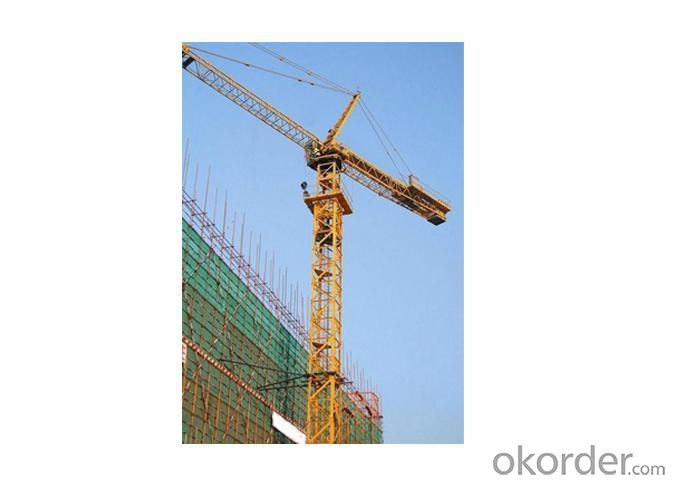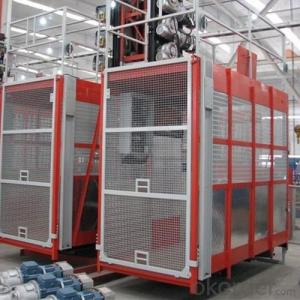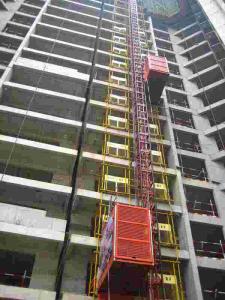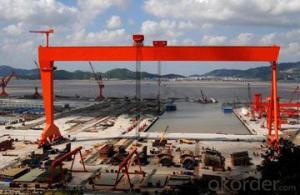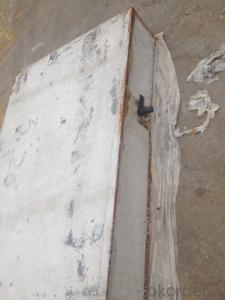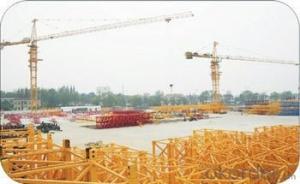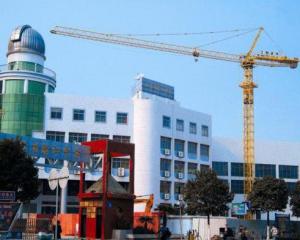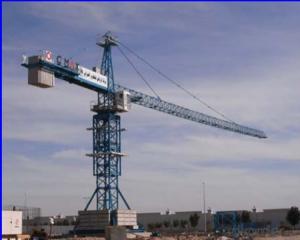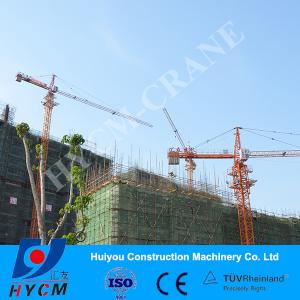QTZ40B Tower Crane
- Loading Port:
- China Main Port
- Payment Terms:
- TT or LC
- Min Order Qty:
- 1 Set set
- Supply Capability:
- 1000 Sets per Year set/month
OKorder Service Pledge
OKorder Financial Service
You Might Also Like
Detailed Product Description of QTZ40B Tower Crane
1.QTZ40B Tower Crane
2.Rated lifting moment:400KN.m
3.Max. lifting load:4t
4.Span:48m
5.Rated lifting load:0.8t
QTZ40B tower crane
CE, GOST (For Russia) and ISO certified tower cranes QTZ25, QTZ30, QTZ40B, QTZ50, QTZ50B, QTZ63, QTZ80, QTZ100, QTZ125, QTZ160, QTZ250 and different kind of construction hoists.
The Tower crane QTZ250 can lift 12 tons, max range 70M, max height 220M.
Table for the Main technical date
The structure name | ITEM | Specification |
Hoisting structure | Motor | YZD200L1-4/8/32 15/15/4Kw |
Decelerator | ZQ50-12.64 | |
Detent | YWZ-300-45 | |
Wire-rope | 6×19-12.5-1770-I-I | |
Slewing mechanism | Motor | YD132M-4/8 3/4.5Kw |
Decelerator | XX4-80.195 | |
Fluid coupling | YOX-250A | |
Slewing fulcrum | HSW.30.1220 | |
Jib lubbing mechanism | Motor | Y100L2-4/6 2.2/1.5kW |
Decelerator | WXJ100-31 | |
Wire-rope | 6×19-6.2-1770-I | |
Hoisting mechanism | Motor | YD132M-4 3kW |
Cylinder stroke | 1320mm | |
Cylinder diameter | 1775mm | |
Rated working pressure for the cylinder | 20MPa |
Table for the main structure
Name | Structure Drawing | The main material | Note |
Standard Segment | Mail staff angle steel: ∠140×140×12 | Section size :1494×1494 height:2200 | |
Jib Boom | First quarter staff: tube76×8 | The Jib boom is formed by eight parts | |
- Q: The user is inquiring about the possibility of purchasing a second-hand construction hoist.
- <p>Yes, you can buy a used building hoist. Many companies specialize in selling refurbished or used construction equipment, including building hoists. You can find them through online marketplaces, auction sites, or by contacting construction equipment dealers directly. It's important to inspect the hoist for any damages or wear and ensure it meets safety standards before purchase. Additionally, consider the hoist's age, maintenance history, and any warranties that might still be valid.</p>
- Q: What about the energy efficiency of the escalator
- The frequency conversion construction elevator is now basically the mainstream product, the effect is good, the failure rate is low and so on the advantage.
- Q: What is the function or use of constructing a building hoist?
- <p>The purpose of building hoists is to facilitate the vertical transportation of materials, equipment, and sometimes personnel during the construction process. They are essential for moving heavy items to various floors or levels of a building under construction. Hoists enhance efficiency, reduce manual labor, and improve safety by minimizing the risk of accidents associated with manual handling of heavy loads. They are particularly crucial in high-rise construction where access is limited and the volume of materials to be moved is substantial.</p>
- Q: Is it possible to utilize a building hoist for the purpose of moving materials up and down in a warehouse setting?
- <p>Yes, a building hoist can be used to lift and lower materials in warehouses. These hoists are designed for vertical transportation of goods and are particularly useful in multi-story warehouses where space is limited. They are capable of handling heavy loads and can be operated manually or with electric power, making them efficient for moving materials between different levels of a warehouse. However, safety measures and proper maintenance are crucial to ensure the secure and effective operation of the hoist.</p>
- Q: This question asks for a comparison of the benefits and drawbacks of utilizing hydraulic fluids in lifting machinery.
- <p>The advantages of using hydraulic fluids in lifting equipment include their ability to transmit power efficiently, provide smooth and controlled movements, and absorb shock and vibration. They also have a high power-to-weight ratio, which is beneficial for lifting heavy loads. Additionally, hydraulic systems are relatively simple to maintain and can operate in a wide range of temperatures. Disadvantages include the potential for leaks, which can be hazardous and costly, and the need for regular maintenance to prevent system failure. Hydraulic fluids can also be environmentally harmful if not disposed of properly, and they may require specific storage conditions to prevent degradation.</p>
- Q: Is it possible for a building hoist to lift more than one object simultaneously?
- <p>Yes, a building hoist can lift multiple objects at once, provided the combined weight does not exceed the hoist's maximum load capacity. The hoist's design and specifications will dictate how many and what types of objects can be lifted simultaneously. It's crucial to follow the manufacturer's guidelines to ensure safety and prevent damage to the hoist or the objects being lifted.</p>
- Q: This question asks about the different types of hydraulic cylinders that are utilized in lifting equipment.
- <p>Hydraulic cylinders used in lifting equipment can be categorized into several types based on their design and application. The main types include: single-acting cylinders, which have one port for fluid and rely on the load or a spring to return; double-acting cylinders, which have ports on both ends and can extend and retract through fluid pressure; telescopic cylinders, which consist of multiple stages that can extend sequentially for greater reach; and rotary hydraulic cylinders, which provide a combination of linear and rotary motion. Each type is chosen based on the specific requirements of the lifting task, such as the need for speed, force, and control.</p>
- Q: This question asks if a building hoist can be set up either inside or outside a building.
- <p>Yes, a building hoist can be installed both indoors and outdoors. The choice between indoor and outdoor installation depends on the specific requirements of the construction project, the available space, and the building's design. Outdoor hoists are often used for high-rise construction, while indoor hoists are more common in multi-story buildings or where external space is limited. Both types require careful planning and adherence to safety regulations to ensure the safe and efficient movement of materials and personnel.</p>
- Q: This question asks if improper functioning or lack of maintenance in hydraulic cylinders can lead to damage.
- <p>Yes, hydraulic cylinders can cause significant damage if they malfunction or are not properly maintained. Malfunctions can lead to leaks, component failure, or even structural damage due to pressure surges. Lack of maintenance can cause wear and tear, leading to reduced efficiency and potential failure. Regular maintenance, including checking for leaks, ensuring proper lubrication, and replacing worn parts, is crucial to prevent damage and ensure the safe operation of hydraulic systems.</p>
- Q: Is it safe to use a lifting device with someone who has no experience with it?
- <p>It is generally not advisable to use a lifting device with someone who is not familiar with it. Lifting devices require proper training and understanding of their operation to ensure safety. Using such equipment without proper knowledge can lead to accidents and injuries. It is crucial to ensure that anyone operating a lifting device has received the necessary training and is familiar with the specific device's safety protocols and operation procedures.</p>
1. Manufacturer Overview
| Location | Beijing,China |
| Year Established | 2003 |
| Annual Output Value | |
| Main Markets | 15.00% Eastern Europe 15.00% South America 10.00% Mid East 10.00% Western Europe 10.00% North America 5.00% Oceania 5.00% Eastern Asia 5.00% Central America 5.00% Southeast Asia 5.00% Northern Europe 5.00% Southern Europe 5.00% South Asia 5.00% Africa |
| Company Certifications | ISO9001:2000;CE |
2. Manufacturer Certificates
| a) Certification Name | |
| Range | |
| Reference | |
| Validity Period |
3. Manufacturer Capability
| a) Trade Capacity | |
| Nearest Port | 11-20 People |
| Export Percentage | 21% - 30% |
| No.of Employees in Trade Department | |
| Language Spoken: | |
| b) Factory Information | |
| Factory Size: | 10,000-30,000 square meters |
| No. of Production Lines | 5 |
| Contract Manufacturing | |
| Product Price Range | |
Send your message to us
QTZ40B Tower Crane
- Loading Port:
- China Main Port
- Payment Terms:
- TT or LC
- Min Order Qty:
- 1 Set set
- Supply Capability:
- 1000 Sets per Year set/month
OKorder Service Pledge
OKorder Financial Service
Similar products
Hot products
Hot Searches
Related keywords

